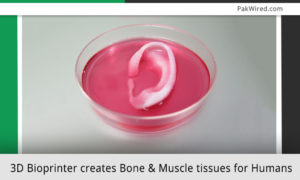Researchers have spent years designing synthetic tissues in the wake of high demand for donars’ organs. Nevertheless, this is not an easy task – many living tissues are too pulpy, soft and gel-like, it’s hard for them to move into a living body, and without the complicated routes in the tissue through which air and other nutrients can travel, the living cells inside can’t survive long.
3D Bioprinter
A team of researchers from U.S. has invented a 3D bioprinter that creates cartilage, bones and muscle tissues that is visible for months when implanted in living organisms. Researchers believe these artificially-created tissues could be used in organs for human transplant.
The machine, known as the Integrated Tissue-Organ Printing System, uses biodegradable polymer that contain living cells, to create synthetic tissues. The mixture is converted into the desired shape through pointed nozzle. The printer is highly sophisticated; it simultaneously creates an outer structure that dissolves once the tissue has hardened, leaving behind a matrix that contains tiny routes through which air and nutrients can reach the living cells. The machine creates same exact shape of the tissues needed by patient’s body.
Experiments using Bioprinters
The researchers have successfully printed a piece of human jawbone, an ear’s outer structure, and a muscles tissue. They implanted these synthesized tissues in rats and mice. After a number of weeks, they checked on the implants, they found an amazing result: Each of the artificial tissues was found in an absolute integration with rat’s own tissues. The synthetic tissues were working well.
Although, the 3D bioprinter takes longer than other tools that make functional synthetic tissues, the structures it produces are large. Larger synthetic tissues posed a structural challenge for researchers who had previously been working on small scale.
Video: Jaw Bioprinting
Test on Humans
It is too early to test these synthetic tissues on humans. Before proceeding with that, researchers intend to create synthetic tissues with many different types of cells from the human body. By doing this, they can extract some of the human’s own cells to place them into the synthetic tissues. It would help the tissues’ integration, making the body more like to accept the transplant.
Source: Popular Science
Image: Wake Forest Institute for Regenerative Medicine


